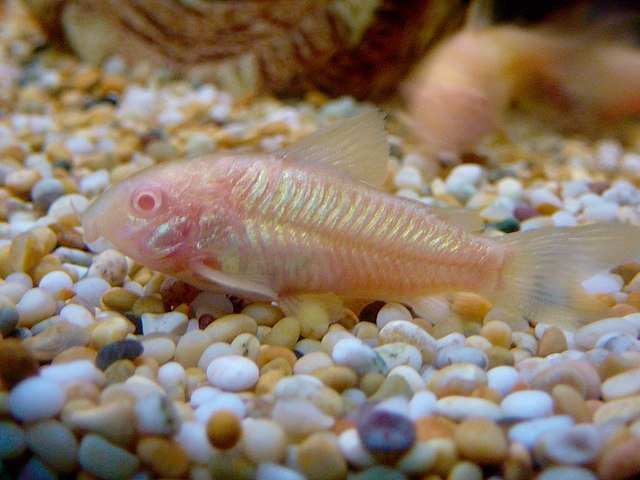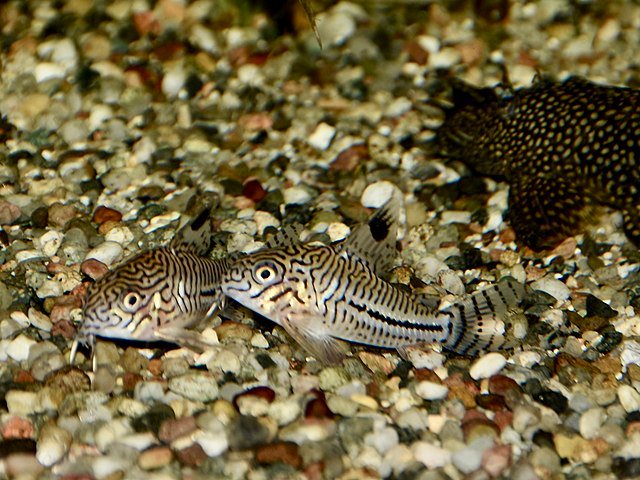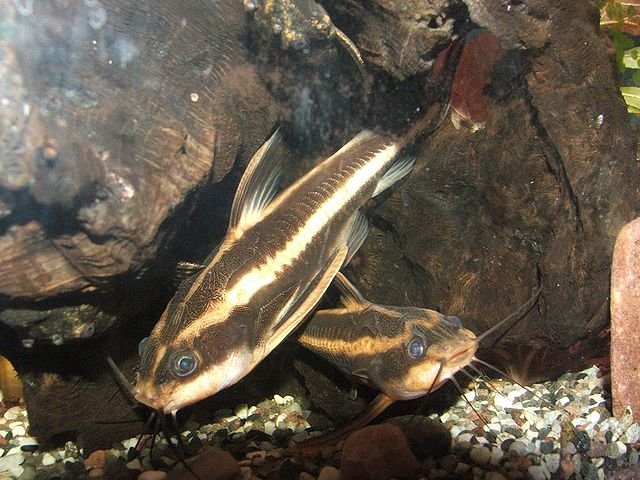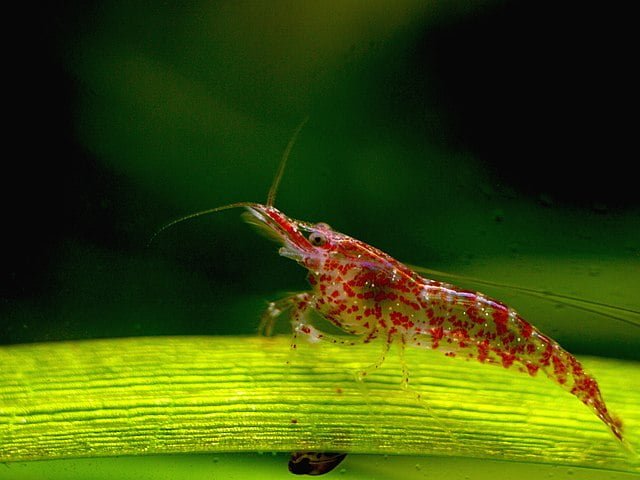
Corydoras is a genus of freshwater catfish that has captured the hearts of aquarium enthusiasts worldwide. These fish are highly recommended for beginner aquarists due to their beauty.
Currently, Corys catfish can be found in ornamental fish stores worldwide at affordable prices. However, the choice between different Corydoras species depends on personal preferences.
The main source of commercially available Corys fish in the ornamental fish market is the capture from Amazonian rivers. However, due to their easy reproduction, the aquaculture of these fish has been encouraged in recent years as an alternative income source for rural communities.
In this article, we will unveil the secrets of Corydoras, providing you with all the essential information you need to maintain and care for these fascinating catfish.
Taxonomy and Types of Corydoras
- 1 Taxonomy and Types of Corydoras
- 2 Characteristics of Corydoras Fish
- 3 Natural Habitat and Behavior of Corydoras
- 4 What do Corydoras eat?
- 5 Reproduction of Corydoras
- 6 Cory Fish Care
- 7 Fish Compatible with Corydoras
- 8 Corydoras Aquaculture
- 9 Diseases
- 10 Conclusion
- 11 Bibliographic References
- 12 Entradas relacionadas:
Corydoras is by far the largest genus of tropical fish, with over 160 species. However, there are around 7 species that are particularly beloved by aquarium enthusiasts: albino Corydora, panda catfish, green Corydora, peppered catfish, pygmy Corydora, Julii Corydora, and emerald Corydora.
It is important to note that the albino Corydora is a variation of the bronze Corydora (Corydoras aeneus). These catfish are specifically bred for the ornamental fish trade, which renders them blind due to the injection of a bright red dye (Hamade, 2021).
Therefore, when purchasing these fish, it is crucial to buy them from aquarium stores that provide guarantees that the Corys fish have been bred under minimum conditions of animal welfare. Here is the general taxonomy of the Corydoras genus, along with their common names in English and Spanish.
Kingdom: Animalia
Stay Always Informed
Join our communities to instantly receive the most important news, reports, and analysis from the aquaculture industry.
Phylum: Chordata
Class: Actinopterygii
Order: Siluriformes
Family: Callichthyidae
Tribe: Corydoradini
Genus: Corydoras
Species: Corydoras aeneus (Bronze Corydora), C. panda, C. paleatus (Peppered Corydora), C. julii (Leopard Corydora), C. pygmaeus (Pygmy Corydora), C. habrosus, C. adolfoi (Adolfo’s Catfish), C. elegans (Elegant Corydora), C. metae (Masked Corydora or Bandit Catfish), C. melini (Bandit Corydora), C. nanus (Dwarf Corydora), C. duplicareus (Duplicate Corydora), C. hastatus (Dwarf Corydora), C. schwartzi (Schwartz’s Catfish)
Common Names in spanish: Corydoras, pez cory, bagre Cory, bagre con armadura, bagre enano
Common Names in English: Cory cats, Armored catfish, Corydoras catfish, Cory fish

Characteristics of Corydoras Fish
The Corydoras catfish are known for displaying a wide variety of body shapes and coloration. Depending on the species, these fish range in size from 2.5 to 12 cm.
However, don’t be fooled by their small size, as these catfish are known for their energetic and active personality. They are agile swimmers and love to explore their environment, making them a vibrant addition to any aquarium.
In general, these dwarf catfish have an elongated and flattened body, with a round head and large eyes. They have prominent pectoral fins and a forked tail, which allows them to move easily through the water.
Additionally, many Corys species have bony plates on their bodies, giving them a distinctive scaly appearance. These plates not only provide protection against predators but also help them camouflage in their natural environment.
An interesting behavior of Corydoras fish is their ability to breathe atmospheric air. Although they have gills to extract oxygen from the water, they can also swim to the water’s surface and directly gulp air from the atmosphere. This is made possible by a special organ called the labyrinth organ, which enables them to breathe air and survive in conditions of low oxygenation in the water.
On the other hand, Hamade (2021) highlights that a common characteristic of many Corys species is their ability to release a venomous mucus through their gills, which causes surrounding fish to die rapidly.
He et al. (2018) conducted a study on venom glands and venom secretions in several species of Corys catfish, and they found that venom secretion was induced by stressful handling of the fish.
Natural Habitat and Behavior of Corydoras
Corydoras fish are native to freshwater habitats in South America. They are mainly found in rivers, streams, and lagoons in Brazil, Colombia, Peru, and other countries in the region.
These catfish prefer habitats with calm waters and sandy or muddy bottoms, where they can search for food and take refuge among aquatic plants and natural hiding spots. Their natural environment is also filled with submerged logs and roots, providing them with places to explore and hide.
As social creatures, Corydoras fish are often found in groups, known as shoals or schools. They exhibit shoaling behavior, which means they tend to swim and interact together, providing a sense of security and better chances of survival.
Their behavior includes scavenging the substrate for food, sifting through sand or detritus to find small organisms and organic matter. They are also known to exhibit occasional playful behavior and are generally peaceful towards other fish species.
Overall, Corydoras fish are not only visually appealing with their unique appearance but also fascinating in their behavior and adaptability to various aquatic environments. Proper care and maintenance will ensure their well-being and allow you to enjoy their vibrant presence in your aquarium.
What do Corydoras eat?
The main diet of Corydoras fish consists of insects that inhabit the bottom of the water and insect larvae, as well as plant matter. Their feeding method involves using their sensory barbels to search the aquarium bottom and suck up food with their mouths.
In captivity, sinking pellets are the best food for Cory catfish. You can also provide them with shrimp food and algae wafers.
Daphnia (water fleas) and bloodworms are excellent food options. Majdi et al. (2018) studied the daily consumption of four different nematode species by C. aeneus and reported that this catfish can consume between 40,581 and 75,849 nematodes per day, recommending the use of the Panagrellus redivivus nematode species.
Experts recommend feeding Corydoras fish once a day, but only an amount they can consume within 5 minutes, then quickly remove any leftover food.
Reproduction of Corydoras
It’s important to note that there is no obvious sexual dimorphism in Corydoras fish. However, males are larger than females in C. aeneus (Kohda et al., 2002). In other species of dwarf catfish, females are slightly larger than males (Gruber et al., 2007).
Female C. aeneus reach sexual maturity at 12.2 months of age, while male Corydoras need 24 months to reach sexual maturity (Mahapatra and Dutta, 2015).
To induce spawning, you should feed both male and female Corydoras with multiple small meals per day, consisting of a protein-rich diet of live or frozen foods, as well as flakes or pellets (Sheppard, 2022). Mahapatra and Dutta (2015) report that cooling the egg-laying substrate greatly stimulates spawning.
In this regard, a common practice to stimulate reproduction is to change one-fourth of the aquarium’s water volume to produce a cooling effect of 3-5 °C (Gruber et al., 2007). Spawning does not occur immediately after the water change; it takes at least 1 or 2 days.
Maulana et al. (2022) recommend using a female-to-male ratio of 1:1 for C. paleatus and report a production of 538 fish per female per week. Under favorable temperature conditions, reproduction takes place within a 10-day interval (Mahapatra and Dutta, 2015).

Female Corydoras will deposit their eggs directly into the water, and the eggs will adhere to aquarium decorations or glass surfaces.
Choi et al. (2019) describe that fertilized eggs of C. adolfoi and C. sterbai are not transparent; they are spherical, demersal, and strongly adhesive, with a size of 1.95 mm and 1.92 mm, respectively. However, in the case of albino C. aeneus, the egg size was 1.70 mm (Park et al., 2017).
Park et al. (2017) describe that albino C. aeneus prelarvae, after hatching, have an average total length of 4.43 mm. They also report that postlarvae on day 15 after hatching have a length of 10.1 mm, and juveniles on day 35 after hatching have a length of 18.5 mm.
Cory Fish Care
To provide Corydoras with a suitable environment, it’s essential to set up the tank appropriately. Here are some guidelines to help you create the perfect environment according to the type of Cory catfish you want to keep:
Table 01. Water quality parameters for each type of Corydora.
| Parameters | Bandit Corydoras C. metae | Bronze or Green Corydoras C. aeneus | Julii Corydoras C. julii | Panda Catfish C. panda | Leopard or Pepper Corydoras C. paleatus | Three-lined Corydora C. trilineatus |
| Maximum Size (cm) | 5 | 6 | 6 | 5 | Male: 6.5 cm Female: 7.5 cm | 6 |
| Lifespan (years) | 5 | 5 | +5 | +10 | 5 | 10 |
| Minimum Tank Size (liters) | 40 | 40 | 40 | 40 | 60 | 40 |
| pH | 6.5 – 7.0 | 6.5 – 7.8 | 6.0 – 7.0 | 6.0 – 7.0 | 5.8 – 7.2 | |
| Hardness (dGH) | 5 – 10 | 20 | 2 – 12 | 12 | 18 | |
| Temperature(oC) | 22 – 26 | 22 – 26 | 23 – 26 | 20 – 25 | 22 – 26 | 22 – 26 |
Some general recommendations include:
- Tank Size: It is recommended to have a tank with a minimum volume of 40 liters, but they thrive better in tanks of 80 liters or more, especially when keeping dwarf catfish with other species. In an 80-liter tank, you can keep a group of 5 fish (Sheppard, 2022).
- Substrate: Opt for a soft and sandy substrate as Cory catfish love to sift through it in search of food. Avoid rough or sharp substrates that can harm their delicate barbels.
- Aquatic Plants: Add broad-leaved and dense aquatic plants to provide shade and hiding places. You can also include submerged logs and roots to simulate their natural habitat. Recommended plants include Java Fern, Crypts, Hornworts, Asian Pennywort, Java Moss, Dwarf Hairgrass, or Amazon Sword.
- Lighting: Provide dim and diffused lighting to replicate natural light conditions in their natural habitat. Corydoras prefer environments with low light.
- Filtration and Water Quality: Install an efficient filtration system to keep the water clean and free from contaminants. Cory catfish are sensitive to water conditions, so it’s important to keep ammonia and nitrite levels under control.

Fish Compatible with Corydoras
In terms of behavior, Corys are known to be social and peaceful fish. They are gregarious animals and feel safer and more comfortable when kept in groups. Keeping at least 6 Corydoras together in an aquarium is recommended to meet their social needs and reduce stress.
They also enjoy the company of other calm and non-aggressive fish species like guppies, platies, swordtails, and mollies. Other types of catfish such as Otocinclus and plecos also get along well with Corydoras.
If you are breeding dwarf catfish, it’s important to avoid including aggressive fish like cichlids, Oscars, or barbs.
Corydoras Aquaculture
In recent years, the cultivation of ornamental fish has been promoted as an alternative to supplement the income of rural communities. In this sense, Corys fish are presented as an alternative due to their high demand in the ornamental fish trade.
Corydoras cultivation generally employs intensive farming technology for low stocking density (500-1000 fish/m2), with a 70-80% survival rate. Diatin et al. (2015) studied the best combination of stocking density and water exchange for juveniles (2.20 to 2.30 cm) of C. aeneus and concluded that the best stocking density for Corydoras fish was 3000 fish/m2, with a daily water exchange of 100%.
Diatin et al. (2019) studied the productivity of bronze Corydoras (C. aeneus) by increasing population density using biofloc technology and reported that the best productivity using biofloc technology was achieved with a population density of 6000 fish/m2.
Diseases
Nematodes
Nematodes are common parasites that affect Corys catfish. In this regard, Rodríguez and Campos (2021) recommend using 25 grams of Albendazole and Metronidazole per kilogram of food to treat infections caused by the nematode Procamallanus (Spirocamallanus) pintoi, which affects C. virginiae.
Conclusion
Corydoras fish are the ideal choice for beginners in the world of aquariums. These catfish adapt well to any community aquarium and complement other fish species nicely.
There is a wide variety of Corydoras fish types to choose from. To select the right type, consider the specific needs of the catfish in terms of water quality and design and implement your aquarium accordingly.
Finally, Corydoras fish farming can become an important alternative for fish farmers due to the high demand in the aquarium market.
Bibliographic References
Choi, E-K, Sohn, JH, Han, SS, Kim, DH. Comparative ultrastructure of the fertilized egg envelope in Corydoras adolfoi and Corydoras sterbai, Callichthyidae, Teleostei. Microsc Res Tech. 2019; 82: 33– 38. https://doi.org/10.1002/jemt.23057
Diatin, I., Suprayudi, M. A., Budiardi, T., & Surawidjaja, E. H. (2015). Intensive culture of corydoras ornamental fish (Corydoras aeneus): evaluation of stocking density and water exchange. Aquaculture, Aquarium, Conservation & Legislation, 8(6), 975-987.
Diatin I., Suprayudi M. A., Budiardi T., Harris E., & Widanarni W. (2019). Biofloc technology on the intensive aquaculture of bronze corydoras ornamental fish Corydoras aeneus with different stocking densities. Jurnal Akuakultur Indonesia, 18(2), 202-213. https://doi.org/10.19027/jai.18.2.202-213
GRUBER, A., STANESCU, R., HOHA, G., & PASARIN, B. 2007. SPECIALITY LITERATURE DATA CONCERNING THE GROWING OF THE SPECIES FROM CORYDORAS GENUS.
Hamade, S. . (2021). The Reversal of Self-Poisoning in Bronze and Albino corydoras: A Recent Study. New Visions in Biological Science Vol. 7, 31–36. https://doi.org/10.9734/bpi/nvbs/v7/15107D
He, J. Y., Huang, V., Min, Y., & Seo, N. E. (2018). Interspecific Comparison of Venom Secretions in Corydoras Catfish.
Kohda, M., Yonebayashi, K., Nakamura, M. et al. Male Reproductive Success in a Promiscuous Armoured Catfish Corydoras Aeneus (Callichthyidae). Environmental Biology of Fishes 63, 281–287 (2002). https://doi.org/10.1023/A:1014317009892
Mahapatra, B.K., Dutta, S. Breeding and Rearing of an Exotic Ornamental Catfish, Corydorus aeneus (Gill, 1858) in Kolkata, West Bengal and Its Economics. Proc Zool Soc 68, 159–163 (2015). https://doi.org/10.1007/s12595-014-0113-8
Majdi, N., Weber, S., & Traunspurger, W. (2018). The early catfish catches the worm: predation of Corydoras aeneus (Siluriformes, Callichthyidae) on freshwater nematodes. In Annales de Limnologie-International Journal of Limnology (Vol. 54, p. 29). EDP Sciences.
Maulana, F., Carman, O., & Putra, A. K. (2022, June). Reproduction performance of corydoras fish Corydoras paleatus spawned with different male to female ratio. In IOP Conference Series: Earth and Environmental Science (Vol. 1033, No. 1, p. 012006). IOP Publishing.
Park, J. M., Yim, H. S., Kho, K. H., & Han, K. H. (2017). Spawning Behavior and Morphological Development of the Larvae and Juveniles of the Corydoras aeneus (Pisces, Callichthyidae). 25, 49-54.
Rodriguez Mendoza, A. C., & Campos Acuña, G. M. (2021). Uso de metronidazol y albendazol en el tratamiento de nemátodos en Corydoras virginiae (Burgess, 1993). Universidad Nacional De La Amazonía Peruana
Sharpe Shirlie. 2021. 7 Cory Catfish Species for Your Aquarium Tank. The Spruce Pets
Sheppard Millie. 2022. Cory Catfish 101: Care, Types, Food, Tank Info, & More. Aquarium Source.
Editor at the digital magazine AquaHoy. He holds a degree in Aquaculture Biology from the National University of Santa (UNS) and a Master’s degree in Science and Innovation Management from the Polytechnic University of Valencia, with postgraduate diplomas in Business Innovation and Innovation Management. He possesses extensive experience in the aquaculture and fisheries sector, having led the Fisheries Innovation Unit of the National Program for Innovation in Fisheries and Aquaculture (PNIPA). He has served as a senior consultant in technology watch, an innovation project formulator and advisor, and a lecturer at UNS. He is a member of the Peruvian College of Biologists and was recognized by the World Aquaculture Society (WAS) in 2016 for his contribution to aquaculture.




